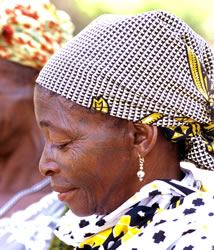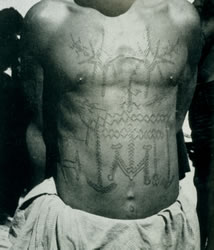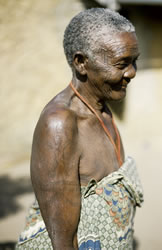Tattoos of Sub-Saharan Africa
Article © 2010 Lars Krutak
Dinembo: The Forbidden Tattoo
Like many African nations, Mozambique has been ravaged by decades of war since the 1960s. Thankfully, the country is on the rebound and its economy is booming due to foreign investment and tourism which attracts intrepid travelers to its incredibly beautiful beaches, pristine national parks, and wildlife reserves.
In the northern province of Cabo Delgado, however, the legacy of the country’s long war for independence is still evident: unexploded landmines, abandoned buildings, and numerous monuments to fallen heroes dot the landscape. In fact, it was here that the struggle of independence from Portugal was born, and it was the Makonde who were the spark that kindled the revolution.
In June 1960, large numbers of Makonde men and women were massacred by Portuguese troops at the town of Mueda. Their bodies were dumped off an imposing cliff near the abandoned airstrip on the outskirts of town. From this point forward, FRELIMO, or the Mozambican Liberation Front, began to grow as Makonde and other men filled its ranks. After ten-years of brutal war, Mozambique finally became independent.
FRELIMO (1964-1989) was not only a liberation movement, it was an official program of political socialism aimed at integrating all Mozambican peoples under its banner through communism. Tribal customs, such as tattooing, were basically outlawed because they were a form of “primitive individual expression” and not conducive to the homogenizing forces of FRELIMO Marxist ideology. In turn, tattoo masters stopped apprenticing their disciples, and Makonde tattooing, or dinembo, became the “forbidden” tattoo. One Makonde man told me that under FRELIMO, there was “No God, and no tattoos. Because God was the Gun.” He continued, “if the Portuguese troops saw your facial tattoos, they knew you were Makonde and they would kill you!”
|
|
 |
| |
This Makonde woman stated: “These tattoos gave us great pride in ourselves. The pain was worth it. You couldn’t get out of it, and we were worried and nervous, but they were completed quickly.”
Makonde facial tattoos always cost more than body tattoos. And around 1940, a completed facial tattoo cost seven times more than body work.
|
Makonde Tattooists and Their Clients
|
|
Generally speaking, men tattooed boys and women the girls although overlap between the sexes did occur to some degree. Makonde tattoo artists were "professionals" who learned their skills usually from their parents or from other family members. Sometimes tattoo artists doubled as traditional healers (curandeiros) who specialized in treating particular medical disorders. Today, many Mozambicans are cut by such healers with two small marks on various parts of their bodies. Medicinal plants are then rubbed into these wounds to relieve such ailments as head pain, respiratory complaints, arthritis, boils, and eye problems. Occasionally, these linear cuts resemble tiny scarifications or even pigmented tattoos. |
 |
"Magical" lizard tattoos were sometimes worn on the chests and backs of Makonde men and women. They were believed to enhance virility for men and fertility for women. Photograph ca. 1950.
|
The general Makonde term for tattoo is dinembo ("design" or "decoration") and the tattooing process usually required one to three sessions with the mpundi wa dinembo ("tattoo design artist") to produce the desired result. If a client’s skin was light, one meeting with the tattooist was usually enough, but those clients with darker complexions paid their tattoo masters several visits. Some boys and girls with darker complexions lost their courage if they had to be tattooed a second or third time and they never completed their tattooing. Those who ran away were ridiculed and even threatened by the woman who acted as their "godmother" during the dinembo rite, because for the Makonde the tattoo ritual was a sign of courage and "to show I am a Makonde." One Makonde woman told me that “men would not be interested in a woman without her markings, and it was obligatory to get the tattoos for this reason or else you could not be married.”
Makonde tattooing practice was a form of skin-cut tattooing. After the cuts were made with traditional knife-like tattoo implements called chipopo, vegetable carbon from the castor bean plant was rubbed into the incisions producing a dark blue color. The tattoos were then washed with water and oil prepared from castor beans was applied with a feather for healing purposes.
Tattoo clients usually paid a nominal fee and were held down in a spread-eagle fashion by relatives or the tattoo artist’s assistant. When the painful facial tattooing was executed, the client was sometimes buried up to their neck in the ground so that they would not flinch during the skin-cutting.
Just before the tattoo artist began to ply the cutting tool, he mentally recorded which designs he would mark upon the skin. Moving carefully over the epidermis, the tattooist cut then rubbed the tattoo pigment into the wound, leaving the client to dry it in the afternoon sun.
Occasionally, young Makonde men who did not live a “respectable” life were only given a few tattoos on the forehead. The tattoo master Pius told me that, “everyone in the village would joke about you because you were not considered to be full Makonde after that.”
Tattoo Motifs
Common decorative motifs such as spiders (lidangadanga), sacred antelope (nandolo), and even yucca root bundles (nkaña) may have had magical associations in the past. And today Makonde women continue to believe that the tattoos placed on their abdomen (mankani) and inner thighs (nchika) are erotic and also have the supernatural power to attract a husband. Of course, the motifs used to decorate these areas, usually palm trees (nadi) or their fruit, and especially the lizard (ligwañula) or a group of lizards (nantchiwane) are believed to enhance fertility.
However, the Makonde practice of tattooing the navel and pubic areas was perhaps related to the long-standing tradition of prophylactic "magic" aimed at warding off penetration or possession by evil forces that targeted vulnerable body passageways, namely the natural openings of the body. Armitage (1924) cites several instances of navel scarification among Bantu-speaking Gonja and Dagomba women in Ghana "put on to ward off or prevent sickness" while the anthropologists Nevadomsky and Aisien described five tattoos stemming from the navel ("the center of life") among the Bini women of Benin. Not surprisingly, the Bini prepared their tattoo pigments from leaves and lampblack (soot), and at funerals mourners "rub a line of lamp-black on their foreheads to scare away the spirit of the deceased who tries to drag his relatives with him to the world of the dead." The Makonde do not practice this ritual, but they do place lumps of charcoal on the woven mats they use for drying their crops to keep evil sorcerers away. |
|
 |
| Elaborate palm frond tattoos adorn the arms of this elderly Makonde woman. |
Next Page | 1
|
2 | 3 |
4 |
5 |
6 |
7 |
8 |
Museum photo gallery of the images
on this page may be seen here.
|



